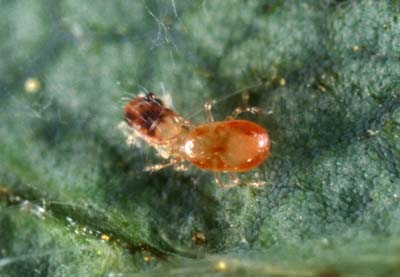
Adult predaceous mite, Neoseiulus californicus.
(Photographer: Lyle Buss, University of Florida)
Males differ in shape and size from females of the same species. Male predatory mites are small (half the size of females), oval, have four pairs of legs and are extremely active. Female predatory mites are shiny, pear-shaped, have four pairs of legs and are about 500 microns in length, or the size of a pinhead. Predatory mites are fast movers and can vary in color from white, tan, red, to brown. Predatory mite eggs are oval in shape and pearl-white in color. Pale-colored mites usually take on the color of their food or substrate.
Females produce about two to four large, oval-shaped eggs per day for a total of about 20 to 50. The life cycle of predatory mites is relatively rapid, lasting about one week.
These mites are found throughout the United States in various habitats on the leaves and stems of plants, trees, shrubs, and grasses.
Predatory mites feed on spider mites, other pest mites and their eggs, and thrips.
Images
To save the Web-optimized images shown below to your hard drive:
|
Click to access Display and Print quality images. |
|
Click to access Display and Print quality images. |
|
Click to access Display and Print quality images. |